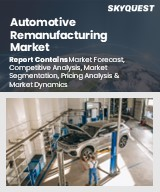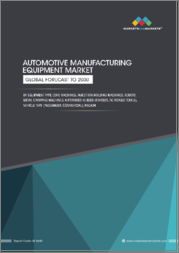
|
시장보고서
상품코드
1796443
자동차 재제조 시장 규모, 점유율, 성장 분석 : 부품 유형별, 차종별, 최종사용자 산업별, 지역별 - 산업 예측(2025-2032년)Automotive Remanufacturing Market Size, Share, and Growth Analysis, By Component Type (Engine and Engine Parts, Transmission and Driveline Components), By Vehicle Type, By End-User Industry, By Region - Industry Forecast 2025-2032 |
||||||
세계의 자동차 재제조 시장 규모는 2023년에 566억 8,000만 달러에 달하며, 예측 기간(2025-2032년)의 CAGR은 7.43%로, 2024년 608억 9,000만 달러에서 2032년에는 1,080억 3,000만 달러로 성장할 전망입니다.
자동차 재제조 시장은 환경 규제 강화, 차량 유지보수 비용 효율화와 지속가능성 강화라는 두 가지 압력으로 인해 눈에 띄는 상승세를 보이고 있습니다. 엔진, 변속기 등 재생부품에 대한 수요는 순환경제의 원칙과 폐기물 감축 목표에 부합하므로 증가하는 추세입니다. 역물류 강화와 핵심 회수 인프라 개선이 이러한 성장에 기여하고 있습니다. 이와 함께 제조업체들은 친환경 대안을 찾는 소비자의 취향에 맞추어 공급망을 조정하고 있으며, 선진국 시장과 신흥 시장 모두에서 꾸준한 성장을 가속하고 있습니다. 재생 부품은 품질을 유지하면서 비용을 크게 절감할 뿐만 아니라 재료 사용량을 최소화하여 탄소 중립을 달성하는 데 중요한 역할을 하며, 산업의 추진력을 더욱 가속화하고 있습니다.
목차
서론
- 조사의 목적
- 조사 범위
- 정의
조사 방법
- 정보 조달
- 1차와 2차 데이터 방법
- 시장 규모 예측
- 시장의 전제조건과 제한
개요
- 세계 시장 전망
- 공급과 수요 동향 분석
- 부문별 기회 분석
시장 역학과 전망
- 시장 개요
- 시장 규모
- 시장 역학
- 촉진요인과 기회
- 억제요인과 과제
- Porter의 산업 분석
주요 시장 인사이트
- 주요 성공 요인
- 경쟁의 정도
- 주요 투자 기회
- 시장 에코시스템
- 시장의 매력 지수(2024년)
- PESTEL 분석
- 거시경제 지표
- 밸류체인 분석
- 가격 분석
- 기술 분석
- 사용 사례
자동차 재제조 시장 규모 : 부품 유형별 & CAGR(2025-2032년)
- 시장 개요
- 엔진과 엔진 부품
- 변속기와 드라이브라인 부품
- 스티어링과 서스펜션 부품
- 브레이크와 브레이크 부품
- 전기 부품
자동차 재제조 시장 규모 : 차종별 & CAGR(2025-2032년)
- 시장 개요
- 승용차
- 소형 상용차
- 대형 상용차
- 건설기계
- 농업 기기
자동차 재제조 시장 규모 : 최종사용자 산업별 & CAGR(2025-2032년)
- 시장 개요
- 자동차 OEM
- 자동차 애프터마켓
- 산업 기기
- 군과 방위
- 에너지 및 유틸리티
자동차 재제조 시장 규모 & CAGR(2025-2032년)
- 북미
- 미국
- 캐나다
- 유럽
- 독일
- 스페인
- 프랑스
- 영국
- 이탈리아
- 기타 유럽
- 아시아태평양
- 중국
- 인도
- 일본
- 한국
- 기타 아시아태평양
- 라틴아메리카
- 브라질
- 기타 라틴아메리카
- 중동 및 아프리카
- GCC 국가
- 남아프리카공화국
- 기타 중동 및 아프리카
경쟁 정보
- 상위 5사의 비교
- 주요 기업의 시장 포지셔닝(2024년)
- 주요 시장 기업이 채택한 전략
- 최근 시장 동향
- 기업의 시장 점유율 분석(2024년)
- 주요 기업의 기업 개요
- 기업의 상세
- 제품 포트폴리오 분석
- 기업의 부문별 점유율 분석
- 매출의 전년대비 비교(2022-2024년)
주요 기업 개요
- ZF Friedrichshafen
- Robert Bosch
- Visteon Corporation
- LKQ Corporation
- Schaeffler Group
- BorgWarner
- Standard Motor Products
- Delphi Technologies
- Cummins
- Allison Transmission
- DENSO Corporation
- Tenneco
결론과 제안
KSA 25.08.29Global Automotive Remanufacturing Market size was valued at USD 56.68 Billion in 2023 and is poised to grow from USD 60.89 Billion in 2024 to USD 108.03 Billion by 2032, growing at a CAGR of 7.43% during the forecast period (2025-2032).
The automotive remanufacturing market is witnessing a notable uptick, driven by the dual pressures of cost efficiency in vehicle maintenance and heightened sustainability efforts amidst stricter environmental regulations. Demand for remanufactured components, such as engines and transmissions, is on the rise as they align with circular economy principles and waste reduction objectives. Enhanced reverse logistics and improved core collection infrastructure are contributing to this growth. In parallel, manufacturers are adapting supply chains to accommodate consumer preferences for eco-friendly alternatives, facilitating steady expansion in both developed and emerging markets. Remanufactured parts not only provide significant cost savings while maintaining quality but also play a vital role in achieving carbon neutrality by minimizing material usage, further bolstering the industry's forward momentum.
Top-down and bottom-up approaches were used to estimate and validate the size of the Global Automotive Remanufacturing market and to estimate the size of various other dependent submarkets. The research methodology used to estimate the market size includes the following details: The key players in the market were identified through secondary research, and their market shares in the respective regions were determined through primary and secondary research. This entire procedure includes the study of the annual and financial reports of the top market players and extensive interviews for key insights from industry leaders such as CEOs, VPs, directors, and marketing executives. All percentage shares split, and breakdowns were determined using secondary sources and verified through Primary sources. All possible parameters that affect the markets covered in this research study have been accounted for, viewed in extensive detail, verified through primary research, and analyzed to get the final quantitative and qualitative data.
Global Automotive Remanufacturing Market Segments Analysis
The global automotive remanufacturing market is segmented into component type, vehicle type, end-user industry, and region. By component type, the market is classified into engine and engine parts, transmission and driveline components, steering and suspension components, brakes and brake components, and electrical components. Depending on the vehicle type, it is bifurcated into passenger cars, light commercial vehicles, heavy commercial vehicles, construction equipment, and agricultural equipment. As per end-user industry, it is categorized into automotive OEM, automotive aftermarket, industrial equipment, military and defense, energy and utilities. Regionally, it is analyzed across North America, Europe, Asia-Pacific, Latin America, and the Middle East and Africa.
Driver of the Global Automotive Remanufacturing Market
The global automotive remanufacturing market is being propelled by a growing emphasis on minimizing carbon footprints and waste, which is steering the industry toward the principles of a circular economy. This shift is supported by various government initiatives that encourage remanufacturing practices, including tax incentives, green procurement strategies, and sustainability programs designed to promote reuse rather than outright replacement of automotive components. As awareness of environmental issues continues to rise, the demand for sustainable practices within the automotive sector is expected to significantly increase, further driving the expansion of remanufacturing as a viable and eco-friendly alternative to traditional manufacturing processes.
Restraints in the Global Automotive Remanufacturing Market
Although advancements in quality and technology have been made, a degree of skepticism persists among certain end-users regarding the reliability and performance of remanufactured products. This hesitance is especially notable in developing regions where awareness and the implementation of certification programs are still evolving. As potential customers weigh the benefits of remanufactured automotive parts against their concerns about longevity and effectiveness, these reservations can significantly hinder market growth. The challenge lies in bolstering consumer confidence through education and robust certification to illustrate the value and dependability of remanufactured offerings in the automotive sector.
Market Trends of the Global Automotive Remanufacturing Market
The global automotive remanufacturing market is experiencing a significant transformation driven by advancements in artificial intelligence and automation technologies. Companies are transitioning from traditional manual inspection methods to sophisticated AI systems that enhance defect detection and evaluation of core parts with remarkable accuracy and speed. This shift is not only improving operational efficiency but also reducing waste through predictive analytics that identify potential failures before disassembly. The integration of automation, such as robotic disassembly and machine-assisted cleaning systems, is further elevating throughput while maintaining quality standards. As demand for remanufactured components continues to rise, the industry's focus on smart factory solutions and AI-driven processes will be critical in addressing labor shortages and ensuring consistent manufacturing performance.
Table of Contents
Introduction
- Objectives of the Study
- Scope of the Report
- Definitions
Research Methodology
- Information Procurement
- Secondary & Primary Data Methods
- Market Size Estimation
- Market Assumptions & Limitations
Executive Summary
- Global Market Outlook
- Supply & Demand Trend Analysis
- Segmental Opportunity Analysis
Market Dynamics & Outlook
- Market Overview
- Market Size
- Market Dynamics
- Drivers & Opportunities
- Restraints & Challenges
- Porters Analysis
- Competitive rivalry
- Threat of substitute
- Bargaining power of buyers
- Threat of new entrants
- Bargaining power of suppliers
Key Market Insights
- Key Success Factors
- Degree of Competition
- Top Investment Pockets
- Market Ecosystem
- Market Attractiveness Index, 2024
- PESTEL Analysis
- Macro-Economic Indicators
- Value Chain Analysis
- Pricing Analysis
- Technology Analysis
- Case Studies
Global Automotive Remanufacturing Market Size by Component Type & CAGR (2025-2032)
- Market Overview
- Engine and Engine Parts
- Transmission and Driveline Components
- Steering and Suspension Components
- Brakes and Brake Components
- Electrical Components
Global Automotive Remanufacturing Market Size by Vehicle Type & CAGR (2025-2032)
- Market Overview
- Passenger Cars
- Light Commercial Vehicles
- Heavy Commercial Vehicles
- Construction Equipment
- Agricultural Equipment
Global Automotive Remanufacturing Market Size by End-User Industry & CAGR (2025-2032)
- Market Overview
- Automotive OEM
- Automotive Aftermarket
- Industrial Equipment
- Military and Defense
- Energy and Utilities
Global Automotive Remanufacturing Market Size by Component Type & CAGR (2025-2032)
- Market Overview
- Engine and Engine Parts
- Transmission and Driveline Components
- Steering and Suspension Components
- Brakes and Brake Components
- Electrical Components
Global Automotive Remanufacturing Market Size by Vehicle Type & CAGR (2025-2032)
- Market Overview
- Passenger Cars
- Light Commercial Vehicles
- Heavy Commercial Vehicles
- Construction Equipment
- Agricultural Equipment
Global Automotive Remanufacturing Market Size by End-User Industry & CAGR (2025-2032)
- Market Overview
- Automotive OEM
- Automotive Aftermarket
- Industrial Equipment
- Military and Defense
- Energy and Utilities
Global Automotive Remanufacturing Market Size & CAGR (2025-2032)
- North America (Component Type, Vehicle Type, End-User Industry, Component Type, Vehicle Type, End-User Industry)
- US
- Canada
- Europe (Component Type, Vehicle Type, End-User Industry, Component Type, Vehicle Type, End-User Industry)
- Germany
- Spain
- France
- UK
- Italy
- Rest of Europe
- Asia Pacific (Component Type, Vehicle Type, End-User Industry, Component Type, Vehicle Type, End-User Industry)
- China
- India
- Japan
- South Korea
- Rest of Asia-Pacific
- Latin America (Component Type, Vehicle Type, End-User Industry, Component Type, Vehicle Type, End-User Industry)
- Brazil
- Rest of Latin America
- Middle East & Africa (Component Type, Vehicle Type, End-User Industry, Component Type, Vehicle Type, End-User Industry)
- GCC Countries
- South Africa
- Rest of Middle East & Africa
Competitive Intelligence
- Top 5 Player Comparison
- Market Positioning of Key Players, 2024
- Strategies Adopted by Key Market Players
- Recent Developments in the Market
- Company Market Share Analysis, 2024
- Company Profiles of All Key Players
- Company Details
- Product Portfolio Analysis
- Company's Segmental Share Analysis
- Revenue Y-O-Y Comparison (2022-2024)
Key Company Profiles
- ZF Friedrichshafen
- Company Overview
- Business Segment Overview
- Financial Updates
- Key Developments
- Robert Bosch
- Company Overview
- Business Segment Overview
- Financial Updates
- Key Developments
- Visteon Corporation
- Company Overview
- Business Segment Overview
- Financial Updates
- Key Developments
- LKQ Corporation
- Company Overview
- Business Segment Overview
- Financial Updates
- Key Developments
- Schaeffler Group
- Company Overview
- Business Segment Overview
- Financial Updates
- Key Developments
- BorgWarner
- Company Overview
- Business Segment Overview
- Financial Updates
- Key Developments
- Standard Motor Products
- Company Overview
- Business Segment Overview
- Financial Updates
- Key Developments
- Delphi Technologies
- Company Overview
- Business Segment Overview
- Financial Updates
- Key Developments
- Cummins
- Company Overview
- Business Segment Overview
- Financial Updates
- Key Developments
- Allison Transmission
- Company Overview
- Business Segment Overview
- Financial Updates
- Key Developments
- DENSO Corporation
- Company Overview
- Business Segment Overview
- Financial Updates
- Key Developments
- Tenneco
- Company Overview
- Business Segment Overview
- Financial Updates
- Key Developments



















